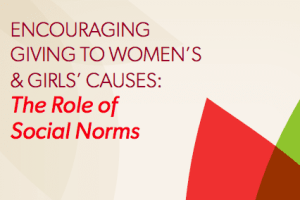
The phenomenon of watching others do something before we do it ourselves: it’s a process that seems hard-wired into humans. And in fact, prior research from the Indiana University Lilly Family School of Philanthropy shows that when we see others giving to charity, we are more inclined to engage in that same giving behavior ourselves.
Now, new research from the Women’s Philanthropy Institute (WPI) investigates how the process of observing giving behavior in others plays out differently for men and women, particularly when they are considering making a donation to women and girls.
Takeaway for Fundraisers: Men Need to See Men Giving
This WPI new research, funded by the Bill & Melinda Gates Foundation, uncovered a significant gender difference: women only need to see other women as role models in order to be influenced toward gender equality giving, whereas men need to see both men and women as role models in order to be influenced toward the behavior.
“Women’s and girls’ organizations and fundraisers in general can use this research to take concrete action to increase their fundraising,” said Debra J. Mesch, Ph.D., the Eileen Lamb O’Gara Chair in Women’s Philanthropy at the Indiana University Lilly Family School of Philanthropy.
One solution to this problem: showcase men giving to women’s and girls’ causes alongside women. This research suggests that fundraising professionals can potentially reach more male donors by featuring testimonials and donor stories from men about their decision to fund women’s and girls’ causes.
The study also notes that fundraisers across philanthropy would do well to apply this finding to any other group of donors that may not be giving to their fullest capacity. The research validates that testimonials and donor spotlights on a diverse range of givers may help more people envision themselves as givers to any cause. “Apply this ‘visibility’ strategy to any group that typically gives less frequently to your organization,” advises the infographic that accompanies the report.
Implications for Philanthropy Media: Showcase Diverse Givers of All Genders and Backgrounds
This study affirms that having visible role models is key for any social movement. As more stories of gender equality giving make it into the mainstream media, more people are able to find role models to envision themselves giving in this way. While publishers in the philanthropy sector like The Chronicle of Philanthropy, Stanford Social Innovation Review, and Inside Philanthropy all cover gender equality giving, it would be helpful if they shared more stories that feature a wider range of givers to gender equality, so that the public has more examples of how different people arrive at gender equality giving as a priority.
Takeaway for Feminist Philanthropy Media (Like Us!): Keep Sharing Stories of Gender Equality Giving
The report speaks to the role that social media sites like Facebook and crowdfunding sites like GoFundMe play in increasing the visibility of people giving. We here at Philanthropy Women would argue that another important part of the landscape for social visibility and discourse around feminist philanthropy is specialized publishing on the subject. Many philanthropy media sites feature stories of gender equality giving, but Philanthropy Women is the only publication specifically dedicated to profiling this uniquely powerful work.
Related:
Research Reveals Common Traits for Gender Equality Givers
Ripple Effect: Longtime Expert to Cultivate Giving Circles Worldwide
Priming the Pump: Exploring Ways to Grow Women’s Giving
New ED and Board Chair of Women Moving Millions Bring Financial and Legislative Power
Empowering Women by Changing Men: Promundo’s Global Fight for Gender Equality

